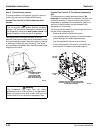
Installation Instructions Section 2
2-18
Part Number 000002688
Replace cap on receiver service valve and tighten.
Open Receiver Service Valve
There is a liquid line solenoid valve at the outlet of the
receiver; refrigerant will not flow to the condensing unit
until the ice machine head section is started. Connect
power to both the ice machine head section and the
Remote condensing unit. Place the ICE/OFF/CLEAN
toggle switch into the ICE position, this will allow
refrigerant to enter the line set and condensing unit.
Step 7 Leak Check The Refrigeration System
Leak check the new line set connections at the ice
machine head section, condensing unit and S trap as
well as all factory joints throughout the entire system.
Disconnect power to the remote condensing unit. Place
the ICE/OFF/CLEAN toggle switch into the ICE position.
This allows the low side and high side pressures to
equalize. Place the ICE/OFF/CLEAN toggle switch in the
OFF position. Connect power to the remote condensing
unit and allow system to pump down.
Step 8 Insulation Requirements
To prevent condensation the entire suction line including
the shut-off valve must be insulated. All insulation must
be airtight and sealed at both ends.
The following insulation requirements prevent
condensation at 90°F (32.2°C) ambient 70% Relative
Humidity. If higher humidity is expected, increase
insulation thickness.
The entire line set, including the suction service valve
located on the back of the ice machine requires:
Important
All refrigeration valve caps must be reinstalled to
prevent future refrigeration leaks.
TURN
COUNTERCLOCKWISE
SV1756
RECEIVER SERVICE VALVE CAP
(TURN COUNTERCLOCKWISE
TO REMOVE)
Suction
Line
Liquid
Line
Min. Insulation
Thickness
3/4 inch
(19.1 mm)
1/2 inch
(12.7 mm)
1/2”(13mm) Suction Line
1/4” (7mm) Liquid Line
Important
To prevent condensation the entire suction line
including the shut off valve must be insulated. All
insulation must be airtight and sealed at both ends.
The minimum requirements are for conditions at or
below 70% humidity and 90°F (32.2°C) ambient.
When higher humidity will be experienced, insulation
wall thickness will need to be increased.


















